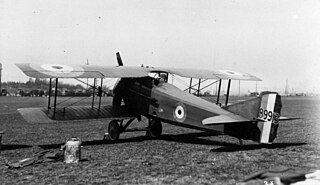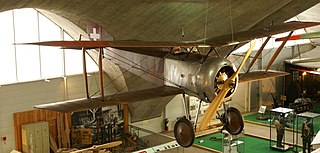
Nieuport, later Nieuport-Delage, was a French aeroplane company that primarily built racing aircraft before World War I and fighter aircraft during World War I and between the wars.

The Nieuport 17 C.1 is a French sesquiplane fighter designed and manufactured by the Nieuport company during World War I. An improvement over the Nieuport 11, it was a little larger than earlier Nieuports and better adapted to the more powerful engine than the interim Nieuport 16. Aside from early examples, it had the new Alkan-Hamy synchronization gear, permitting the use of a fuselage-mounted synchronised Vickers gun firing through the propeller disc.

The SPAD S.XIII is a French biplane fighter aircraft of the First World War, developed by Société Pour L'Aviation et ses Dérivés (SPAD) from the earlier and highly successful SPAD S.VII.

The SPAD S.VII C.1 was the first in a series of single-seat biplane fighter aircraft produced by Société Pour L'Aviation et ses Dérivés (SPAD) during the First World War. Like its successors, the S.VII was renowned as a sturdy and rugged aircraft with good diving characteristics. It was also a stable gun platform, although pilots used to the more maneuverable Nieuport fighters found it heavy on the controls. It was flown by a number of the famous aces, such as France's Georges Guynemer, Italy's Francesco Baracca and Australia's Alexander Pentland.

The Sopwith 1+1⁄2 Strutter is a British single- or two-seat multi-role biplane aircraft of the First World War. It was the first British two-seat tractor fighter and the first British aircraft to enter service with a synchronised machine gun. It was given the name 1+1⁄2 Strutter because of the long and short cabane struts that supported the top wing. The type was operated by both British air services and was in widespread but lacklustre service with the French Aéronautique Militaire.

The Morane-Saulnier N, also known as the Morane-Saulnier Type N, was a French monoplane fighter aircraft of the First World War. Designed and manufactured by Morane-Saulnier, the Type N entered service in April 1915 with the Aéronautique Militaire designated as the MoS-5 C1. It also equipped four squadrons of the Royal Flying Corps, in which it was nicknamed the Bullet, and was operated in limited numbers by the 19th Squadron of the Imperial Russian Air Force.

The Nieuport 11, nicknamed the Bébé, is a French World War I single seat sesquiplane fighter aircraft, designed by Gustave Delage. It was the primary aircraft that ended the Fokker Scourge in 1916. The type saw service with several of France's allies, and gave rise to the series of "vee-strut" Nieuport fighters that remained in service into the 1920s.

The Nieuport 27 was a World War I French sesquiplane fighter aircraft designed by Gustave Delage. The 27 was the last of the line of Nieuport "V-strut" single seat fighters that began with the Nieuport 10 of 1914. Operational examples supplemented the very similar Nieuport 24 and 24bis in operational squadrons in late 1917 and many would also be used as advanced trainers.

The Nieuport 28 C.1, a French biplane fighter aircraft flown during World War I, was built by Nieuport and designed by Gustave Delage. Owing its lineage to the successful line of sesquiplane fighters that included the Nieuport 17, the Nieuport 28 continued a similar design philosophy of a lightweight and highly maneuverable aircraft.

The Voisin III was a French World War I two-seat pusher biplane multi-purpose aircraft developed by Voisin in 1914 as a more powerful version of the 1912 Voisin L. It is notable for being the aircraft used for the first successful shooting down of an enemy aircraft on October 5, 1914, and to have been used to equip the first dedicated bomber units, in September 1914.

The Hanriot HD.1 is a French World War I single-seat fighter aircraft. Rejected for service with French squadrons in favour of the SPAD S.VII, the type was supplied to the Aviation Militaire Belge and the Corpo Aeronautico Militare of the Royal Italian Army, with both of which it proved highly successful. Of a total of about 1,200 examples built, 831 were produced by Italian companies under licence.

The Nieuport 12 was a French sesquiplane reconnaissance, fighter aircraft and trainer used by France, Russia, Great Britain and the United States during World War I. Later production examples were built as trainers and served widely until the late 1920s.

The SPAD S.A was a French two-seat tractor biplane first flown in 1915. It was used by France and Russia in the early stages of the First World War in the fighter and reconnaissance roles. It was a unique aircraft that carried its observer in a nacelle ahead of wing, engine and propeller.

The Morane-Saulnier AI is a French parasol-wing fighter aircraft that was produced by Morane-Saulnier during World War I.

The Nieuport 14 was a military reconnaissance sesquiplane produced in France during the First World War. The French Army deployed it in 1916 but the type was quickly withdrawn from front-line service.

The Nieuport 16 C.1 was a French World War I single-seat sesquiplane fighter aircraft, designed by Gustave Delage as a development of the Nieuport 11 with a more powerful engine. The Nieuport 16's service life coincided with the period when the first air-to-air rockets, the Le Prieur rocket, were used most frequently, and the type has a closer association with them than any other aircraft.

The Nieuport 17bis C.1 was a World War I French single-seat sesquiplane fighter that was produced under licence in the United Kingdom in small numbers for the Royal Naval Air Service.
Escadrille Spa.68 was a French fighter squadron active from Autumn 1915 until the Armistice that ended World War I. It was equipped with a mixed lot of Nieuports until they were gradually replaced by SPADs in November 1917. The squadron was one of four bundled into Groupe de Combat 20 in February 1918. By war's end, Escadrille Spa.68 was credited with the destruction of 15 enemy aircraft.
Escadrille Spa.153 was a French fighter squadron active from 1 July 1917 to war's end. It was Mentioned in dispatches for its proficiency. By the Armistice, the squadron was credited with 10 German airplanes and three observation balloons destroyed.
Escadrille Spa.100 was a French fighter squadron active during the last 11 months of World War I. Flying combat as a component of larger fighter formations, Escadrille Spa.100 was credited with destroying 11 German airplanes and 12 observation balloons between 16 January and 11 November 1918.






















